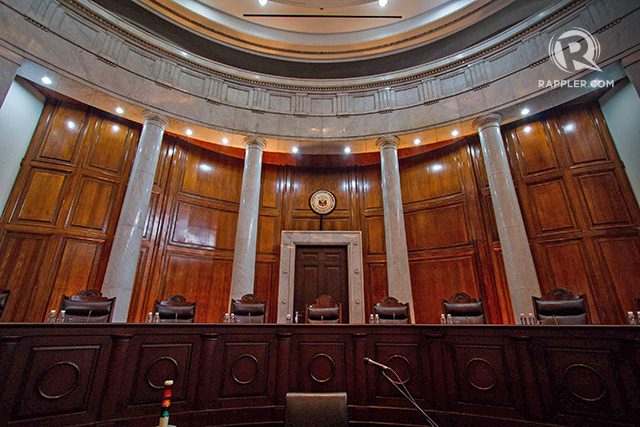SUMMARY
This is AI generated summarization, which may have errors. For context, always refer to the full article.

MANILA, Philippines – In a reversal of his position in January, the Office of the Solicitor General said the construction of Torre de Manila is “illegal” and should be removed because it violates constitutional provisions on the preservation of cultural artifacts.
“The Torre de Manila significantly alters the physical integrity of the Rizal Monument. In the case of the Rizal Monument, its physical integrity necessarily includes its sightline,” Solicitor General Florin Hilbay said in a position paper dated July 30, 2015.
The Solicitor General’s new position comes a few days before the second round of arguments on Tuesday, August 4.
It will now be the turn of the respondents to present their side in the debate over whether or not the construction of the 49-storey condominium should be stopped because it mars the sightline of the historic Rizal Monument.
A first round of oral arguments held two weeks ago saw magistrates grill the Knights of Rizal on the merits of their opposition to the controversial Torre de Manila.
The Solicitor General represents government respondents National Commission for Culture and the Arts, National Museum, and the National Historical Commission of the Philippines.
Hilbay said these institutions “had no direct participation” in the granting of permits and licenses for the construction of Torre de Manila.
The Supreme Court is hearing arguments on the September 2014 petition filed by the Knights of Rizal, which seeks to have Torre de Manila demolished because it marred the “visual dominance” of the Rizal Monument in Luneta Park.
The group also claimed that the building violated heritage laws and local zoning regulations.
SolGen’s new position
In its January position paper, the Solicitor General said that there was “clearly no sufficient legal basis” that would justify the issuance of a cease and desist order (CDO) by the NHCP to stop the project.
At the time, Hilbay noted that the building was constructed on private property, in an area “which is way beyond the protected buffer zone of the Rizal Monument and the Rizal Park.”
But in his new position paper, Hilbay argued that the Rizal Monument – the obelisk, statue, and its sightline – should be taken and seen as an integrated unit that must be protected.
“As a national cultural treasure or cultural property, the Rizal Monument was intended to be, and has always been, seen with a clear sightline. One cannot divorce the obelisk and the statue – the Motto Stella – from the park in the same way that one cannot divorce the obelisk and the statue from the sightline. The sightline is as much a part of the Rizal Monument because it is a visual phenomenon,” he said.
Because of this, the construction of the condominium which heritage advocates have slammed for being clearly visible behind the monument of the national hero should be stopped.
“With specific reference to the present controversy, the only way to “conserve” the Rizal Monument is by removing the impediment to its sightline: the presence of Torre de Manila,” Hilbay added.
Hilbay also said that co-respondent City of Manila committed “grave abuse of discretion” when it issued zoning and building permits despite the building’s non-compliance with local zoning laws, which would have limited Torre de Manila to only 7 floors.
Should the High Court rule in favor of the petitioners, Hilbay said that the national government is “not required to compensate private parties for the exercise of acts that are illegal or unconstitutional.”
But whether or not DMCI is entitled to compensation from the city of Manila was a “different matter,” the Solicitor General added.
‘No laws violated’
The building’s developer, DMCI Homes, has repeatedly denied allegations that it violated zoning and heritage laws. It referred to the documents and clearances the company received for the construction of Torre de Manila.
It also cited a November 2012 letter from the NHCP stating that as the building was outside the Rizal Park, it “cannot possibly obstruct the front view of the said National Monument.”
In its comment, the city of Manila also affirmed the validity of the permits issued to DMCI, including the clearance exempting the project from local zoning laws.
“In the final analysis, the indubitable fact is that all permits, clearances, and certificates granted to Torre de Manila by respondent City of Manila as well as those of the concerned regulatory agencies of the National Government are valid and remain official and legally binding,” the comment read.
In January 2014, the Manila Zoning Board of Adjustments and Appeals (MZBAA) approved the construction of Torre de Manila after DMCI appealed for an exemption to the local zoning laws.
First round
In the first round of hearings on July 21, SC magistrates repeatedly grilled the petitioner’s counsel, William Jasarino, to identify what laws the high-rise residential building supposedly violated.
They also asked Jasarino for evidence that DMCI built the building in “bad faith,” and to explain why Torre de Manila should be opposed when the housing project is built on private property outside the protected buffer zone of the park.
Several SC justices also took exception to the petitioner’s move of elevating their petition to the High Court and skipping the lower trial courts.
The second round of oral arguments will be held at 2 pm on Tuesday.
Among other issues, the High Court seeks to determine whether the constitutional mandate to conserve and protect cultural heritage and resources – such as the historic Rizal Monument – also extends to the preservation of its “prominence, dominance, vista points, vista corridors, sight lines and setting.” – Rappler.com
Add a comment
How does this make you feel?
There are no comments yet. Add your comment to start the conversation.